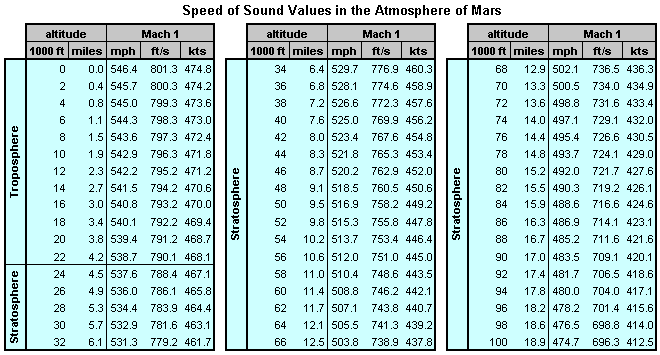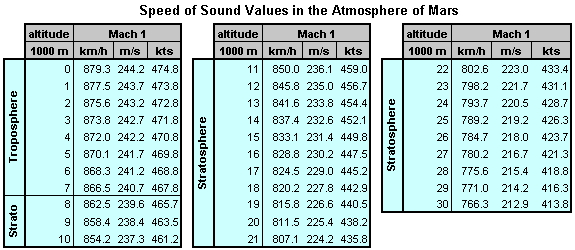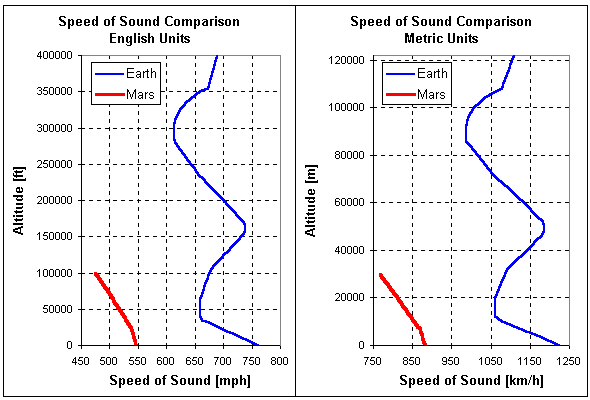|
||||||||||
| Location: Home > %7Eaerospa1 > ask a rocket scientist > atmosphere > q0249 | ||||||||||
|
|
||||||||||
|
||||||||||
| Location: Home > %7Eaerospa1 > ask a rocket scientist > atmosphere > q0249 | ||||||||||
|
|
||||||||||

Luckily, NASA and other space agencies have sent several spacecraft to Mars that have collected measurements of its atmosphere to create such a model. One probe that conducted a particularly comprehensive study of the atmosphere was NASA's Mars Global Surveyor launched in 1996. NASA has used data collected by this craft to construct a preliminary standard atmosphere model for Mars comparable to the 1976 standard atmosphere developed for Earth. This model will likely be revised in the future once more readings of the Martian atmosphere are collected, but it does provide the information needed to calculate an approximation of the speed of sound on Mars.
As we have seen in previous articles, the equation used to calculate the speed of sound is
where
In English units, the first equation models the lower atmosphere and applies up to an altitude of 22,960 ft. The second equation is used above that altitude for the upper atmosphere to an altitude of 100,000 ft. These two regions of the atmosphere are referred to as the troposphere and stratosphere just like on Earth.
where
where
| convert | into | conversion |
|---|---|---|
| Fahrenheit | Rankine | add 459.67 |
| Celsius | Kelvin | add 273.15 |
We now have all the information needed to calculate the speed of sound at any altitude within the Martian atmosphere. As an example, let us use the data provided above to solve for the speed of sound at an altitude of zero. At this lowest point within the atmosphere, the temperature profile equations tell us that the "sea level" temperature within the standard atmosphere is -25.68°F or -32°C. Converting these units to an absolute temperature scale produces values of 434°R in the English system and 241 K in Metric units. Let us now solve the speed of sound equation using these values.

This methodology tells us that the standard "sea level" speed of sound on Mars is equal to

This next table is in the Metric System and indicates the speed of sound in kilometers per hour (km/h), meters per second (m/s), and knots (kts) for altitudes from 0 m to 30,000 m in 1,000 m increments.

Note that these tables are also color-coded like those previously presented for Earth's atmosphere. The atmosphere on our planet features regions where the temperature decreases (blue), increases (red), and remains a constant (green). The Martian atmosphere, on the other hand, grows continually colder with increasing altitude, so these tables only include the color blue. The rate at which the temperature decreases becomes more rapid around 22,960 ft (7,000 m), and this point defines the boundary between the troposphere and stratosphere.
Since the temperature within the Martian atmosphere is always decreasing, the speed of sound also decreases at the same rate. The behavior of the speed of sound within the atmosphere of Mars is compared to that on Earth in the following figure. Here we can clearly see the continually decreasing speed of sound on Mars compared to the much more complex behavior observed on Earth.

Readers should be aware that the atmosphere of Mars is much less stable than that of Earth making it more difficult to establish a standard atmosphere model. Because the atmosphere is so thin, the temperature at any given location and altitude varies considerably more so than on Earth. These fluctuations in temperature between day and night have such a strong influence on the atmosphere that the troposphere can be anywhere from 6 to 12 miles (10 to 20 km) high during the day to non-existent at night.
This behavior was observed at the sites of the Viking landers that reached Mars in 1976. At the warmest time of
day, the ground temperature was near freezing but the air temperature at altitude was considerably lower. This
difference in temperature created convection air currents and a troposphere. At night, both ground and air
temperatures dropped much lower but were about the same temperature. This lack of a significant temperature
difference eliminated the convection process and caused the troposphere to vanish. Additional fluctuations due to
location and seasonal change also produce large variations in atmospheric behavior on Mars.
- answer by Jeff Scott, 30 October 2005
Related Topics:
Read More Articles:


|
Aircraft | Design | Ask Us | Shop | Search |

|
|
| About Us | Contact Us | Copyright © 1997-2025 | |||
| Location: Home > %7Eaerospa1 > ask a rocket scientist > atmosphere > q0249 | |||
|
|
|||